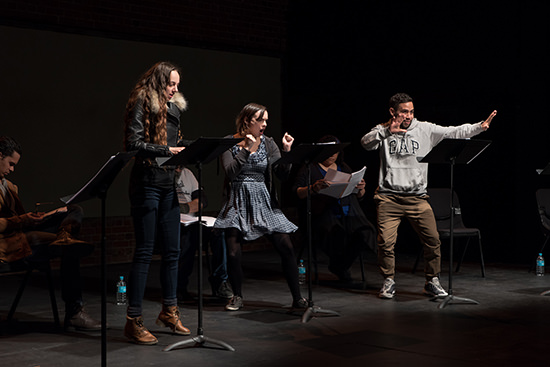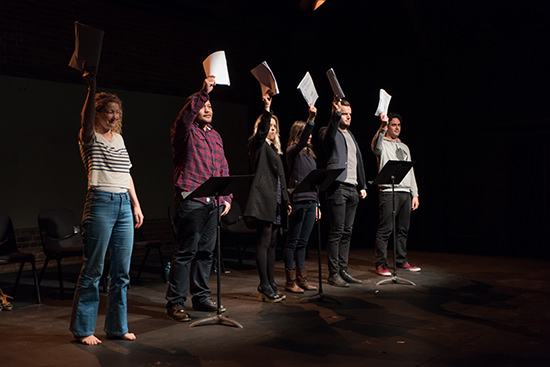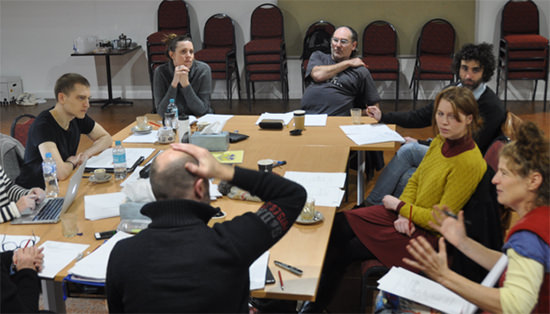 |
Reading of Melodie Reynolds-Diarra’s Skylab, National Play Festival 2016 photo Cameron Hart |
Successor to the long-running Australian National Playwrights’ Conference, Playwriting Australia’s National Play Festival is now in its ninth year. At its centre is a program of full and partial readings of new works developed through PWA’s various strands. There are also regionally focused showcases featuring excerpts by emerging playwrights; industry forums and artist panels; talks and master classes. A litmus test of Australian playwriting, the festival is also a community of spirit: a rare opportunity for playwrights and other stakeholders—directors, dramaturgs, actors and producers—to come together over the course of four days to debate, discuss and embolden.
This year’s festival, held at Melbourne’s Malthouse Theatre, was notable for being the last before it shifts from an annual to biennial format, a consequence of funding cuts to the Australia Council. Happily, the high level of artistry evident throughout the festival’s four days of readings assuaged lingering discontent with this state of affairs.
Cultural diversity in play
Perhaps most impressive were this year’s two regional showcases, Lotus and Aotearoa Now, which featured works by Asian-Australian and New Zealand playwrights respectively. Formally daring and possessed of a striking energy, excerpts from these plays provided tantalising glimpses into cultures and dramaturgies that remain woefully under-represented on Australian stages. They also reflect a welcome and sustained focus on cultural diversity at PWA: of the festival’s 13 playwrights, seven were non-Anglo, as were 15 of the 27 actors involved in the play readings.
This diversity was also evident across the main program of six plays, four of which were by female playwrights, including the wildly inventive Skylab by Indigenous actor Melodie Reynolds-Diarra. An emphatic, almost sui generis fusion of her Wangkathaa heritage, pop culture influences and an alternate history of the falling to Earth in WA of the Skylab space station in 1979, the play marks the first time Australia’s three major Indigenous performing arts companies—Yirra Yaakin, Ilbijerri and Moogahlin—have collaborated on a single work. It could be described as magic-realist, but it is wholly distinct from the Latin American tradition.
Among Skylab’s creative team is Iain Sinclair, PWA’s Resident Dramaturg, who spoke to me about the special challenge of applying dramaturgy to works arising from, or incorporating, non-Western playwriting and performance traditions. It’s a conversation that seemed especially pertinent given not only the festival’s majority non-Anglo makeup, but also its overarching theme of ‘craft,’ which saw much discussion—flowing on from Michael Gow’s keynote address (“The Agony and the Agony: A Totally Impractical Guide to Playwriting”)—turn to dramaturgical first principles rather than the big picture questions which predominated at last year’s festival.
 |
Aotearoa Now acknowledging the audience, National Play Festival 2016 photo Cameron Hart |
An emergent dramaturgy
Sinclair describes Skylab as a “beautiful dance,” a metaphor that neatly suggests a reciprocal, non-hierarchical model of dramaturgy that is flexible and needs-based. “When the idea of craft is applied as a closed system,” he says, it can imprison ideas rather than release them.” If pioneering companies such as the Australian Performing Group (APG) initiated the breakdown of a British dramaturgical model based on the well-made play in the 1970s, then Sinclair sees culturally diverse artists as those most likely to lead what he calls a “post-enlightenment” dramaturgy that is responsive to the needs of individual plays, emerging “somewhere in the meeting point between cultures as a new Australian dramaturgy.” Sinclair nominates Indonesian-Australian playwright Shari Indriani’s Squint Witch, which featured in the Lotus showcase, as an example of this emergent dramaturgy, freely mixing “sacred performance, Gen Y neuroses and traditional Indonesian puppet theatre.”
As a further illustration, Sinclair points to Isaac Drandic, actor, writer and Associate Director of Ilbijerri, whom Playwriting Australia is now in the process of teaming with playwrights who the company feels stand to benefit from his craft—as a kind of dramaturgical gun for hire. This is, in conjunction with PWA’s dramaturgy mentoring program now in its fifth year, all part of a long-term strategy to centralise the role of dramaturgs in the development of new Australian work.
“Australian dramaturgy,” says Sinclair, “is in a process of evolution. We have largely moved on from the typical dramaturgy of the 80s and 90s—a ‘Pinterising’ style led by deficit thinking that was always asking ‘what is wrong with this play, what can we cut to fix it?’—to a next level dramaturgy that is fluid and artistically orientated. But unquestionably we are still a few years behind America and Europe.” The key for playwrights who want to develop their craft, Sinclair believes, is industry exposure (easier if you’re based in New York) and familiarity with the work of as many other writers as possible. Exposure is crucial for dramaturgs too. Sinclair reckons it takes being in the room for 10 to 15 productions before anything teachable can be learned, but humility is also vital: “dramaturgy,” he tells me, “is less about dictating form or taste than being an advocate for what the medium does best.”
In the first instance, Sinclair believes, this is simply the art of rendering ideas into behaviours. It’s an idea that can be applied equally to the Lotus plays, with their often complex interaction of inherited and contemporary cultural traditions and to the six works—Skylab, Melissa Reeves’ The Zen of Table Tennis, Steve Rodgers’ King of Pigs, Olivia Satchell’s I Sat and Waited but You Were Gone Too Long, Chris Summers’ Pedagogy and first-time playwright Emily Sheehan’s Hell’s Canyon—that comprised this year’s main program.
 |
Workshop, Melissa Reeves’ (bottom R) The Zen of Table Tennis, National Play Festival 2016 photo Cameron Hart |
Stage-ready
At various stages of development, only two of these works feel stage-ready: King of Pigs and The Zen of Table Tennis, the latter surely in danger of what Sinclair calls ‘shop spoiling,’ so long has the script been around under different titles. Both plays are bold, finely crafted takes on difficult issues—domestic violence and trauma respectively—but it is Reeves’ signature humour and eccentricities of character that add up to the richer vision; all the more reason to wish for its rapid progress to full production. Taken as a whole, it might be argued that it is a shortage of ambition rather than craft that undermines the progress of some plays; small casts, narrow concerns and an absence of politics confirm in my mind Hannie Rayson’s assertion during her master class that Australian playwrights are, broadly speaking, reluctant to write about those in positions of power.
But that, I suppose, is a question of inspiration, and perhaps a topic for another festival—one that will no doubt build on this year’s considerable achievements in diversity and craftsmanship—to unpack.
Playwriting Australia: The National Play Festival, Malthouse Theatre, Melbourne, 27-30 July
RealTime issue #134 Aug-Sept 2016 pg.
© Ben Brooker; for permission to reproduce apply to [email protected]








 back
back